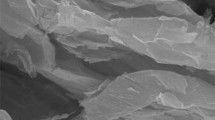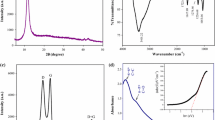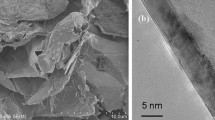Abstract
This paper presents the influence of the volume concentration (VC) and temperature on the viscosity and thermal conductivity (TC) of a graphene–Fe3O4/water hybrid nanofluid. The experiments were done for volume concentrations (VCs) of 0.1% to 0.5% at temperatures of 20°C to 60°C. The results show that the thermal conductivity ratio (TCR) increases with the VC and temperature. Moreover, the TCR grew more with the VC percent at higher temperatures. The maximum increase in the TC was 34% at a VC of 0.5% at 60°C. The viscosity got up with the VC and decreased with temperature growth. The maximum increase in the relative viscosity (RV) was 6% at a VC of 0.5% at 60°C. Therefore, the VC affects the viscosity and TC, and a new correlation was suggested according to experimental results with good accuracy.










Similar content being viewed by others
REFERENCES
Al-Rabeeah, A.Y., Seres, I., and Farkas, I., Experimental Investigation and Performance Evaluation of Parabolic Trough Solar Collector for Hot Water Generation, J. Eng. Therm., 2021, vol. 30, pp. 420–432.
Sedaghat, F., Yousefi, F., and Zolfaghari, H., Experimental Investigation and Modeling of S, N-GQDs Nanofluid Density Using New Equation of State and Artificial Neural Network, J. Eng. Therm., 2019, vol. 28, pp. 276–290.
Hassanzadeh, R. and Tokgoz, N., Thermal-Hydraulic Characteristics of Nanofluid Flow in Corrugated Ducts, J. Eng. Therm., 2017, vol. 26, pp. 498–513.
Urmi, W., Rahman, M.M., and Hamzah, W.A.W., An Experimental Investigation on the Thermophysical Properties of 40% Ethylene Glycol Based TiO2-Al2O3 Hybrid Nanofluids, Int. Commun. Heat Mass Transfer, 2020, vol. 116, p. 104663.
Zhang, X. and Zhang, Y., Heat Transfer and Flow Characteristics of Fe3O4–Water Nanofluids under Magnetic Excitation, Int. J. Therm. Sci., 2021, vol. 163, p. 106826.
Achard, F. and Maxwell, J.C., A Treatise on Electricity and Magnetism, in Landmark Writings in Western Mathematics 1640–1940, Elsevier, 2005, pp. 564–587.
Sandhya, M., Ramasamy, D., Sudhakar, K., Kadirgama, K., Samykano, M., Harun, W.S.W., et al., A Systematic Review on Graphene-Based Nanofluids Application in Renewable Energy Systems: Preparation, Characterization, and Thermophysical Properties, Sustain. Energy Technol. Assess., 2021, vol. 44, p. 101058.
Al-Rabeeah, A.Y., Seres, I., and Farkas, I., Recent Improvements of the Optical and Thermal Performance of the Parabolic Trough Solar Collector Systems, Facta Univesitatis, Ser.: Mech. Engin., 2021; https://doi.org/10.22190/FUME201106030A
Pavı́a, M., Alajami, K., Estellé, P., Desforges, A., and Vigolo, B., A Critical Review on Thermal Conductivity Enhancement of Graphene-Based Nanofluids, Adv. Colloid Interface Sci., 2021, p. 102452.
Ahmad, F., Abdal, S., Ayed, H., Hussain, S., Salim, S., and Almatroud, A.O., The Improved Thermal Efficiency of Maxwell Hybrid Nanofluid Comprising of Graphene Oxide Plus Silver/Kerosene Oil over Stretching Sheet, Case Stud. Therm. Eng., 2021, vol. 27, p. 101257.
Alnaqi, A.A., Alsarraf, J., and Al-Rashed, A.A.A.A., Hydrothermal Effects of Using Two Twisted Tape Inserts in a Parabolic Trough Solar Collector Filled with MgO-MWCNT/Thermal Oil Hybrid Nanofluid, Sustain. Energy Technol. Assess., 2021, vol. 47, p. 101331.
Esfe, M.H., Ahangar, M.R.H., Rejvani, M., Toghraie, D., and Hajmohammad, M.H., Designing an Artificial Neural Network to Predict Dynamic Viscosity of Aqueous Nanofluid of TiO2 Using Experimental Data, Int. Comm. Heat Mass Transfer, 2016, vol. 75, pp. 192–196.
Sundar, L.S., Mesfin, S., Ramana, E.V., Said, Z., and Sousa, A.C.M., Experimental Investigation of Thermo-Physical Properties, Heat Transfer, Pumping Power, Entropy Generation, and Exergy Efficiency of Nanodiamond + Fe3O4/60: 40% Water-Ethylene Glycol Hybrid Nanofluid Flow in a Tube, Therm. Sci. Eng. Prog., 2021, vol. 21, p. 100799.
Mehrali, M., Sadeghinezhad, E., Akhiani, A.R., Latibari, S.T., Talebian, S., Dolatshahi-Pirouz, A., et al., An Ecofriendly Graphene-Based Nanofluid for Heat Transfer Applications, J. Clean. Prod., 2016, vol. 137, pp. 555–566.
Asadi, A., Alarifi, I.M., and Foong, L.K., An Experimental Study on Characterization, Stability and Dynamic Viscosity of CuO-TiO2/Water Hybrid Nanofluid, J. Mol. Liq., 2020, vol. 307, p. 112987.
Okonkwo, E.C., Wole-Osho, I., Kavaz, D., Abid, M., and Al-Ansari, T., Thermodynamic Evaluation and Optimization of a Flat Plate Collector Operating with Alumina and Iron Mono and Hybrid Nanofluids, Sustain. Energy Technol. Assess., 2020, vol. 37, p. 100636.
Al-Oran, O., Lezsovits, F., and Aljawabrah, A., Exergy and Energy Amelioration for Parabolic Trough Collector Using Mono and Hybrid Nanofluids, J. Therm. An. Calorim., 2020, pp. 1–18.
Estellé, P., Halelfadl, S., and Thierry, M., Thermal Conductivity of CNT Water Based Nanofluids: Experimental Trends and Models Overview, J. Therm. Eng., 2015, vol. 1, pp. 381–390.
Bushehri, M.K., Mohebbi, A., and Rafsanjani, H.H., Prediction of Thermal Conductivity and Viscosity of Nanofluids by Molecular Dynamics Simulation, J. Eng. Therm., 2016, vol. 25, pp. 389–400.
Li, X., Zou, C., Wang, T., and Lei, X., Rheological Behavior of Ethylene Glycol-Based Sic Nanofluids, Int. J. Heat Mass Transfer, 2015, vol. 84, pp. 925–930.
Afrand, M., Toghraie, D., and Ruhani, B., Effects of Temperature and Nanoparticles Concentration on Rheological Behavior of Fe3O4–Ag/EG Hybrid Nanofluid: An Experimental Study, Exp. Therm. Fluid Sci., 2016, vol. 77, pp. 38–44.
Xian, H.W., Sidik, N.A.C., Aid, S.R., Ken, T.L., and Asako, Y., Review on Preparation Techniques, Properties and Performance of Hybrid Nanofluid in Recent Engineering Applications, J. Adv. Res. Fluid Mech. Therm. Sci., 2018, vol. 45, pp. 1–13.
Sundar, L.S., Singh, M.K., and Sousa, A.C.M., Enhanced Heat Transfer and Friction Factor of MWCNT–Fe3O4/Water Hybrid Nanofluids, Int. Comm. Heat Mass Transfer, 2014, vol. 52, pp. 73–83.
Baby, T.T. and Sundara, R., Synthesis and Transport Properties of Metal Oxide Decorated Graphene Dispersed Nanofluids, J. Phys. Chem. C, 2011, vol. 115, pp. 8527–8533.
Arzani, H.K., Amiri, A., Kazi, S.N., Chew, B.T., and Badarudin, A., Experimental and Numerical Investigation of Thermophysical Properties, Heat Transfer and Pressure Drop of Covalent and Noncovalent Functionalized Graphene Nanoplatelet-Based Water Nanofluids in an Annular Heat Exchanger, Int. Comm. Heat Mass Transfer, 2015, vol. 68, pp. 267–275.
Mohan, V.B., Lau, K., Hui, D., and Bhattacharyya, D., Graphene-Based Materials and Their Composites: A Review on Production, Applications and Product Limitations, Compos. Part B Eng., 2018, vol. 142, pp. 200–220.
Olabi, A.G., Abdelkareem, M.A., Wilberforce, T., and Sayed, E.T., Application of Graphene in Energy Storage Device—A Review, Renew. Sustain. Energy Rev., 2021, vol. 135, p. 110026.
Huang, J., Yang, L., and Xie, Y., Why the Thermal Conductivity of Graphene Nanofluids is Extremely High?—A New Model Based on Anisotropy and Particle-Free Renovation, J. Mol. Liq., 2021, p. 117326.
Wole-Osho, I., Okonkwo, E.C., Kavaz, D., and Abbasoglu, S., An Experimental Investigation into the Effect of Particle Mixture Ratio on Specific Heat Capacity and Dynamic Viscosity of Al2O3–ZnO Hybrid Nanofluids, Powder Technol., 2020, vol. 363, pp. 699–716.
Babar, H., Sajid, M.U., and Ali, H.M., Viscosity of Hybrid Nanofluids: A Critical Review, Therm. Sci., 2019, vol. 23, pp. 1713–1754.
Kazemi, I., Sefid, M., and Afrand, M., A Novel Comparative Experimental Study on Rheological Behavior of Mono and Hybrid Nanofluids Concerned Graphene and Silica Nano-Powders: Characterization, Stability and Viscosity Measurements, Powder Technol., 2020, vol. 366, pp. 216–229.
Mehrali, M., Sadeghinezhad, E., Rosen, M.A., Latibari, S.T., Mehrali, M., Metselaar, H.S.C., et al., Effect of Specific Surface Area on Convective Heat Transfer of Graphene Nanoplatelet Aqueous Nanofluids, Exp. Therm. Fluid Sci., 2015, vol. 68, pp. 100–108.
Harandi, S.S., Karimipour, A., Afrand, M., Akbari, M., and D’Orazio, A., An Experimental Study On Thermal Conductivity of F-MWCNTs–Fe3O4/EG Hybrid Nanofluid: Effects of Temperature and Concentration, Int. Comm. Heat Mass Transfer, 2016, vol. 76, pp. 171–177.
Author information
Authors and Affiliations
Corresponding author
Rights and permissions
About this article
Cite this article
Al-Rabeeah, A.Y., Seres, I. & Farkas, I. Effects of Concentration and Temperature on the Viscosity and Thermal Conductivity of Graphene–Fe3O4/Water Hybrid Nanofluid and Development of New Correlation. J. Engin. Thermophys. 31, 328–339 (2022). https://doi.org/10.1134/S1810232822020138
Received:
Revised:
Accepted:
Published:
Issue Date:
DOI: https://doi.org/10.1134/S1810232822020138




